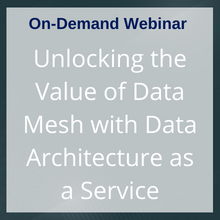Self-Service Data or Cohesive Data Architecture: A Dilemma Resolved

ABSTRACT: The emerging Data-Architecture-as-a-Service (DaaS) paradigm resolves a long-standing conflict between self-service data and architectural consistency.
When I read Wayne Eckerson’s article, Data Architecture-as-a-Service: Liberation for Data Users, I immediately could see many benefits to extending and enhancing data architecture with the as-a-service model. This is an exciting idea—an idea whose time has come—and it really is an essential next step in self-service data and analytics. Data-Architecture-as-a-Service (DaaS) has the potential to resolve many of the challenges of managing data in the age of self-service. My goal with this short article is to describe some of the advantages that I see, and to perhaps accelerate interest in and adoption of DaaS.
Architectural consistency is the most obvious advantage. Architecture is the glue that holds together all of the many complex parts of data management. Things that are out of sync with architecture become fragmented, inconsistent, and confusing. Self-service data that propagates data silos is a familiar and frequently occurring example. Architectural cohesion among local and end-user data repositories can substantially reduce fragmentation, inconsistency, and confusion. Ultimately this becomes a shift from data silos to interoperability among locally managed data domains.
DaaS will drive a shift from data silos to interoperability among locally managed data domains.
Reduced data waste is one very important effect of architectural consistency. Chad Sanderson, who heads up the data platform at Convoy, Inc., makes this point well in a LinkedIn post. “One of the most underestimated data problems is the concept of Data Waste. Data Waste occurs when data is replicated (partially or completely), unmaintained, and generally unused.” He goes on to describe two big problems with data waste: “it directly contributes to a diverging understanding of key business concepts” and “it results in Data Confusion.” DaaS will help to reduce waste, enhance shared understanding, and reduce data confusion.
Data waste contributes to diverging understanding of business concepts
and it results in data confusion.
Adoption of standards by self-service data consumers will become commonplace. The tension between enterprise standards and self-service autonomy often creates conflict within organizations. Yet one of the most important parts of architecture is establishing standards for the things that we build and the ways that we build them—standards that often have strong influences on data privacy, data protection, data quality, technological agility, and more. We always have greater success with standards when it is easier to comply with them than to violate them.
Architectural standards have strong influences on data privacy, data protection, data quality, technological agility, and more.
Reuse of designs and processes among self-service data consumers becomes practical when architectural consistency exists. Reusable concepts and components can be directly applied to accelerate data preparation work, with many of them created as components of enterprise data architecture. The possibilities here are endless. Consider data pipeline design patterns and data connectors for the data lake as examples.
Reusable concepts and components can be directly applied to accelerate data preparation work.
Collaboration and federation become practical with consistency in the way that various departments and workgroups organize and work with data. Shared data, shared processing, and shared analysis make cross-departmental collaboration and federated analytics practical. This has real business benefits in increased communication and common understanding of business dynamics.
Shared data and analysis make cross-departmental collaboration and federated analytics practical. This has real business benefits.
In conclusion I fully support Wayne’s premise that it “is possible to abstract architecture and build it into easy-to-use, customer-facing tools.” Beyond possible, it is an essential next step. Early movement in this direction by companies such as Coalesce and Stitch are only the beginning of what I hope becomes a big shift in data management, data architecture, and self-service.





 Analyst Series - Data Fabric: The Next Step in the Evolution of Data Architectures
Analyst Series - Data Fabric: The Next Step in the Evolution of Data Architectures
 Operational Data Architecture
Operational Data Architecture
 Slides: Unlocking the Value of Data Mesh with Data Architecture as a Service
Slides: Unlocking the Value of Data Mesh with Data Architecture as a Service
 Webinar: Unlocking the Value of Data Mesh with Data Architecture as a Service
Webinar: Unlocking the Value of Data Mesh with Data Architecture as a Service
 Data Architecture as a Service: How to Evaluate Products
Data Architecture as a Service: How to Evaluate Products
